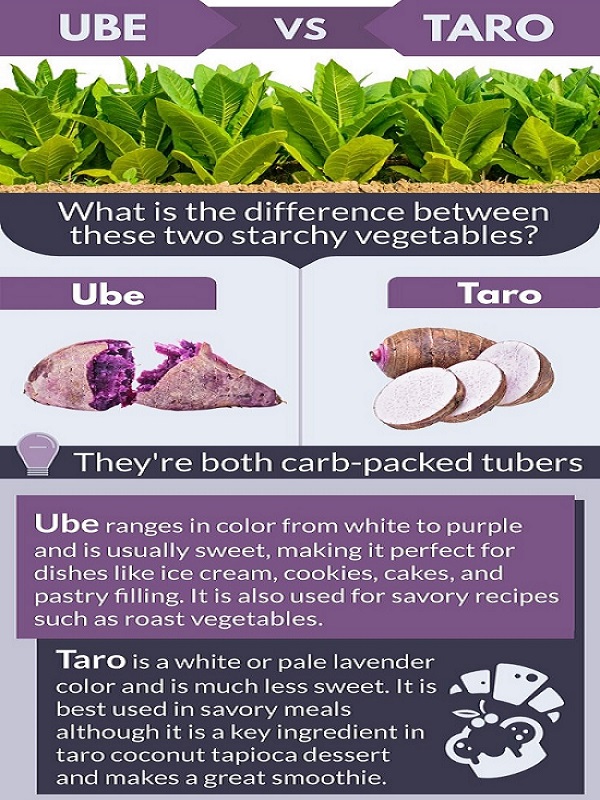Ube vs Taro

In this article, we’ll explore the fascinating comparison between two root vegetables that often get mistaken for each other: Ube and Taro. Despite their similarities in appearance, taste, and culinary applications, they come from different plants and offer distinct flavors and nutritional profiles.
Origin and Cultivation
Ube, scientifically known as Dioscorea alata, is native to Southeast Asia, particularly the Philippines. It has been cultivated for centuries in tropical and subtropical regions. Conversely, Taro belongs to the Colocasia esculenta family and is believed to have originated in South India and Southeast Asia. It’s widely cultivated in tropical and subtropical regions worldwide.
Appearance and Taste
1. Color and Texture
Its vibrant purple hue characterizes Ube, while taro typically has pale, purplish skin with white or purple flesh. In terms of texture, ube tends to be denser and smoother than taro’s slightly grainier texture.
2. Flavor Profile
Ube boasts a sweet, nutty flavor with hints of vanilla, making it a popular choice for desserts. Taro, on the other hand, offers a more subtle, earthy flavor with a slightly starchy texture, often likened to that of a potato.
Nutritional Value
1. Macronutrients
Both ube and taro are low in fat and protein but are rich sources of carbohydrates, providing a good source of energy. However, taro tends to have slightly higher fiber content compared to ube.
2. Micronutrients
Ube and taro are both packed with essential vitamins and minerals, including vitamin C, vitamin E, potassium, and manganese. Additionally, they contain antioxidants that help protect cells from damage caused by free radicals.
Culinary Uses
1. Traditional Dishes
In Filipino cuisine, ube is commonly used in desserts such as ube halaya (jam), ube ice cream, and cakes. Taro, on the other hand, is a staple ingredient in savory dishes like taro chips, taro cake, and taro bubble tea.
2. Modern Applications
With the rise of culinary innovation, both ube and taro are finding their way into a wide range of modern dishes and beverages, including pancakes, waffles, smoothies, and even cocktails.
Health Benefits
1. Antioxidant Properties
Both ube and taro contain antioxidants that help reduce inflammation and lower the risk of chronic diseases such as heart disease and cancer.
2. Digestive Health
The fiber content in ube and taro promotes digestive health by aiding in regular bowel movements and preventing constipation.
3. Potential Risks
However, it’s essential to consume ube and taro in moderation as excessive intake may lead to an increase in blood sugar levels, especially for individuals with diabetes.
Popular Variations
1. Ube Halaya vs. Taro Paste
Ube halaya is a popular Filipino dessert made from mashed purple yams, coconut milk, and condensed milk, resulting in a rich, creamy texture. Taro paste, on the other hand, is commonly used in Chinese
2. Ube Ice Cream vs. Taro Ice Cream
Ube ice cream, also known as purple yam ice cream, is a beloved Filipino dessert characterized by its vibrant color and creamy texture. Taro ice cream, on the other hand, offers a more subtle flavor with a hint of sweetness, making it a popular choice in Asian-inspired desserts.
3. Availability and Accessibility
While both ube and taro are widely available in their native regions, they may be harder to find in other parts of the world. However, with the growing popularity of Asian cuisine, these ingredients are becoming more accessible in specialty grocery stores and online markets.
Cultural Significance
1. Philippine Cuisine
Ube holds a special place in Filipino culture and cuisine, often symbolizing celebrations and festivities. It’s commonly served during special occasions like birthdays, weddings, and holidays.
2. Southeast Asian Cuisine
Taro plays a significant role in Southeast Asian cuisine, where it’s used in a variety of dishes, including soups, stews, and desserts. Its versatility and nutritional benefits make it a staple ingredient in many traditional recipes.
Growing Global Trend
In recent years, there has been a surge in popularity for both ube and taro, thanks to their unique flavors, vibrant colors, and versatility in cooking. They have become trendy ingredients in the culinary world, appearing in everything from pastries and beverages to savory dishes and snacks.
Ube and Taro in Desserts
One of the most common uses for ube and taro is in desserts, where their natural sweetness and vibrant colors shine. From ube cakes and taro mochi to ube cheesecake and taro pudding, the possibilities are endless when it comes to incorporating these root vegetables into sweet treats.
Sustainability and Environmental Impact
As demand for ube and taro continues to grow, there are concerns about the sustainability of their cultivation practices. Farmers need to adopt environmentally friendly methods to ensure the long-term viability of these crops and minimize their impact on the ecosystem.
Comparison in Popularity
While both ube and Taro have gained popularity in recent years, they each have their dedicated fan base. Ube is particularly trendy in the West, thanks to its eye-catching color and unique flavor, while taro remains a staple in Asian cuisine worldwide.
Conclusion
While ube and taro share some similarities, they are distinct ingredients with their own unique characteristics and cultural significance. Whether you’re indulging in a slice of ube cake or savoring a bowl of taro soup, these root vegetables offer a delightful culinary experience that transcends borders and cultures.
FAQs
Are ube and Taro the same thing?
No, ube and taro are two different root vegetables with distinct flavors, textures, and nutritional profiles.
Can I substitute ube for taro in recipes?
While they may have similar appearances, ube, and taro have different flavors, so substituting one for the other may alter the taste of your dish.
Are ube and taro healthy to eat?
Yes, both ube and taro are nutritious ingredients that offer a range of health benefits, including antioxidants and essential vitamins and minerals.
Where can I buy ube and Taro?
Depending on your location, you can find ube and taro at Asian grocery stores, specialty markets, and online retailers.
What are some popular dishes made with ube and taro?
Popular dishes include ube halaya, ube ice cream, taro chips, taro cake, and taro bubble tea.



